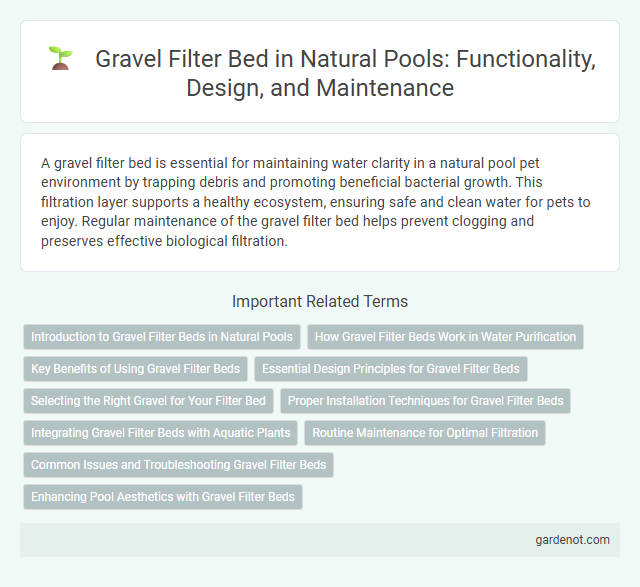A gravel filter bed is essential for maintaining water clarity in a natural pool pet environment by trapping debris and promoting beneficial bacterial growth. This filtration layer supports a healthy ecosystem, ensuring safe and clean water for pets to enjoy. Regular maintenance of the gravel filter bed helps prevent clogging and preserves effective biological filtration.
Introduction to Gravel Filter Beds in Natural Pools
Gravel filter beds in natural pools serve as a biological filtration system that removes impurities and promotes water clarity through natural processes. These beds consist of layered gravel and sand, providing a habitat for beneficial microorganisms that break down organic matter and reduce harmful bacteria. Their design facilitates efficient water circulation and oxygenation, crucial for maintaining a balanced and healthy aquatic environment without chemical additives.
How Gravel Filter Beds Work in Water Purification
Gravel filter beds enhance water purification by trapping suspended particles and promoting biological filtration through their porous structure. Water flows downward through layers of different-sized gravel, which physically removes debris while supporting beneficial microorganisms that break down organic contaminants. This natural filtration process improves water clarity and quality in natural pools without the use of chemicals.
Key Benefits of Using Gravel Filter Beds
Gravel filter beds enhance natural pool water quality by efficiently trapping debris and promoting beneficial bacterial growth that breaks down contaminants. Their porous structure supports excellent water circulation and oxygenation, reducing the need for chemical treatments. This sustainable filtration method extends the lifespan of the pool ecosystem while maintaining clear, healthy water.
Essential Design Principles for Gravel Filter Beds
Gravel filter beds in natural pools rely on layered aggregates with varying sizes to enhance biological filtration and promote water clarity. Proper grading of gravel ensures efficient flow distribution and prevents clogging, while sufficient depth provides ample surface area for beneficial microorganisms to thrive. Selecting inert, durable materials and maintaining consistent permeability are essential design principles to optimize the long-term functionality of gravel filter beds.
Selecting the Right Gravel for Your Filter Bed
Selecting the right gravel for your natural pool filter bed involves prioritizing clean, angular, and uniformly sized gravel between 3 to 8 mm to maximize filtration efficiency and minimize clogging. Using washed quartz gravel enhances water clarity due to its durability and resistance to chemical leaching, supporting the biological filtration process essential for natural pool ecosystems. Proper gravel selection improves water flow through the filter bed, promoting effective removal of debris and maintaining balanced aquatic conditions.
Proper Installation Techniques for Gravel Filter Beds
Proper installation techniques for gravel filter beds in natural pools involve selecting graded gravel with uniform size to ensure optimal water filtration and prevent clogging. Layering the gravel bed with a geotextile fabric beneath helps to stabilize the structure and enhances biological filtration by promoting beneficial microbial growth. Ensuring even compaction and maintaining appropriate bed depth, typically between 30 to 60 centimeters, maximizes filtration efficiency and supports a balanced aquatic ecosystem.
Integrating Gravel Filter Beds with Aquatic Plants
Gravel filter beds enhance water purification in natural pools by promoting beneficial microbial activity that breaks down organic matter. Integrating aquatic plants such as water lilies and reeds within the gravel layer optimizes nutrient uptake and oxygenation, improving overall water clarity. This synergy between gravel filtration and plant root systems creates a balanced ecosystem, reducing the need for chemical treatments and mechanical filtration.
Routine Maintenance for Optimal Filtration
Routine maintenance of a gravel filter bed is essential for sustaining optimal filtration in a natural pool. Regularly removing debris and flushing the gravel helps prevent clogging and maintains water clarity. Inspections should include checking for sediment buildup and ensuring water flows uniformly through the gravel bed to support efficient biological filtration.
Common Issues and Troubleshooting Gravel Filter Beds
Gravel filter beds in natural pools often face clogging due to fine sediment accumulation, reducing water flow and filtration efficiency. Regular backwashing or surface raking can help restore permeability and prevent anaerobic zones that promote algae growth. Inspecting gravel size distribution and eliminating organic debris also mitigates common blockages within the filtration media.
Enhancing Pool Aesthetics with Gravel Filter Beds
Gravel filter beds enhance natural pool aesthetics by creating a seamless transition between the water and surrounding landscape, using natural materials that blend effortlessly with plantings and stone features. The varied textures and colors of gravel add visual interest and depth, promoting a harmonious and organic appearance. This filtration method supports clear, clean water without the need for harsh chemicals, maintaining the pool's natural beauty and eco-friendly appeal.
Gravel filter bed Infographic

 gardenot.com
gardenot.com